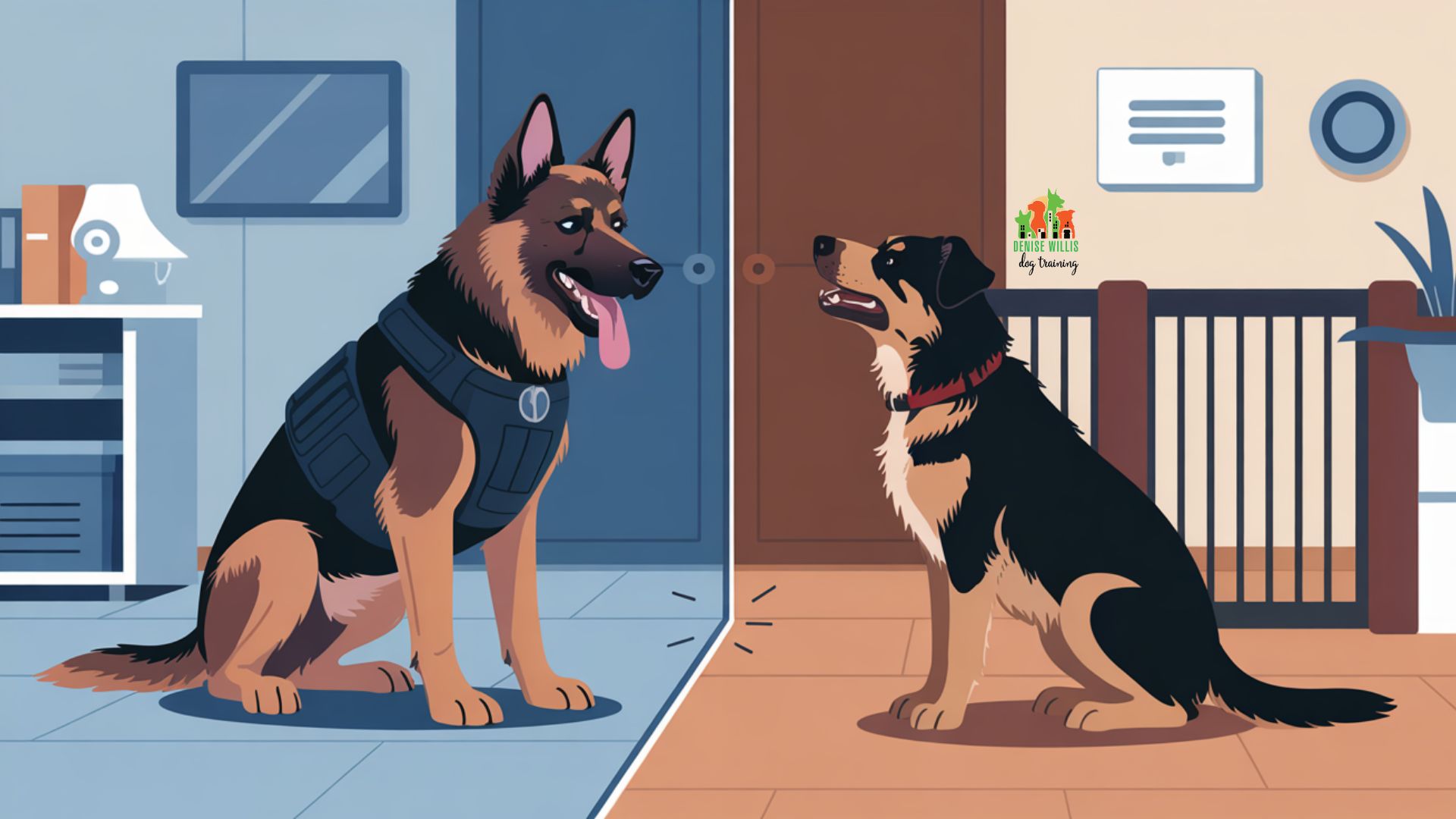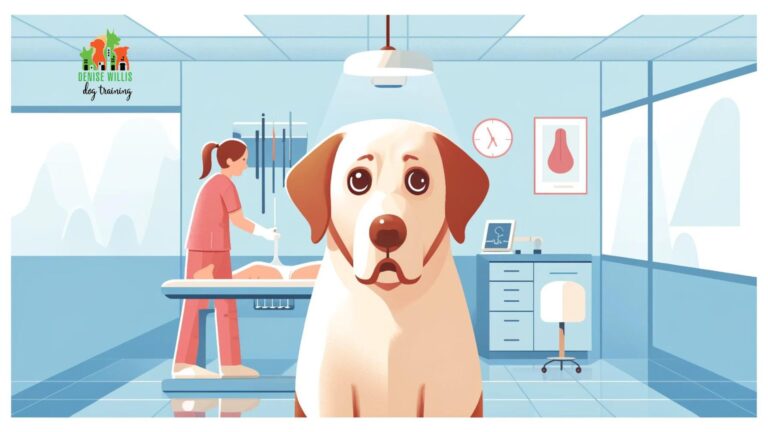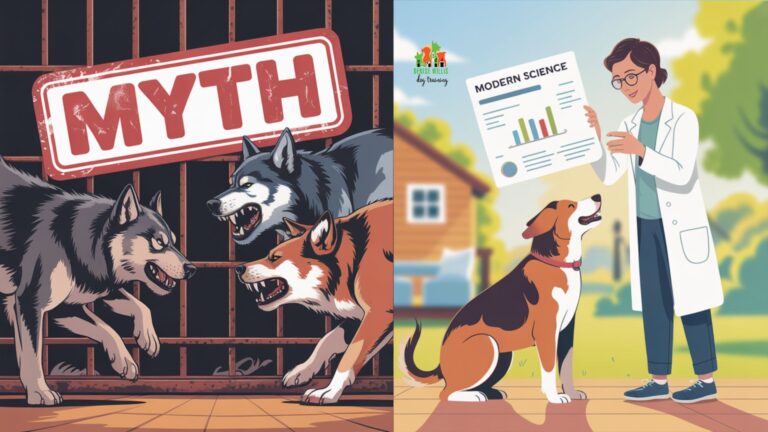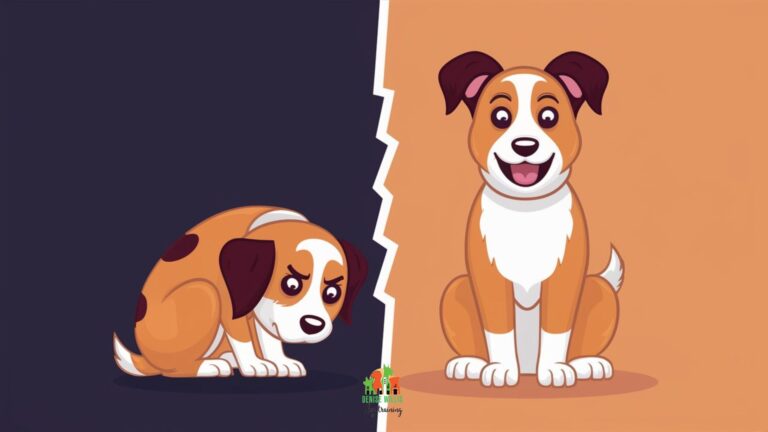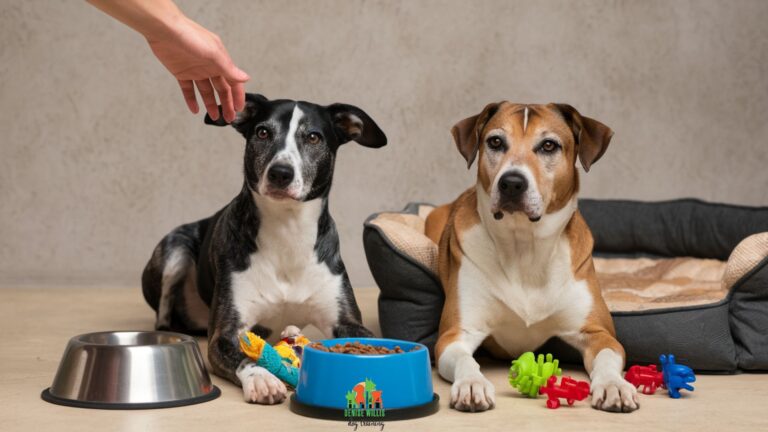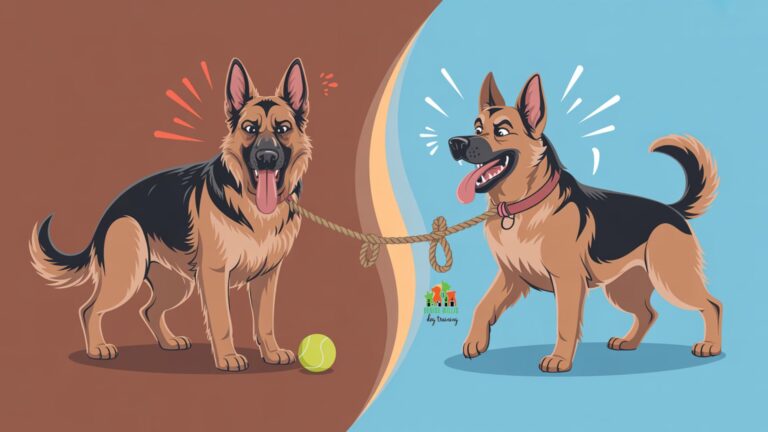From Field to Family: Managing Aggression in Working Dogs and Pets
📍 Service Area Notice: DW Dog Training provides in-person training services exclusively in the Greater Baltimore area. While our blog content is designed to help dog owners internationally, our hands-on training services are locally focused. For readers outside our service area, we hope you find value in our articles and welcome you to reach out with questions!
Have you ever witnessed your calm, friendly dog transform into an unrecognizable creature when someone approaches their food bowl or steps onto your property?
Aggression in working dogs and pets affects millions of owners who find themselves walking on eggshells around their own four-legged family members. Behind every growl, snap, or lunge lies a complex interplay of genetics, training history, and environmental factors that shape these challenging behaviors.
When your German Shepherd goes from loyal companion to fierce guardian in seconds, or your sweet Beagle becomes a resource-hoarding tyrant over a simple chew toy, you’re experiencing a fundamental canine communication system at work. Dogs don’t develop aggression randomly or maliciously. Their displays serve specific purposes, whether they’re specialized working animals trained for protection or beloved family pets reacting to perceived threats.
Most owners struggle to connect their dog’s heritage with their modern home life. That playful nipping from your Border Collie puppy might seem cute until it escalates into herding-based aggression toward children. Meanwhile, your neighbor’s retired police K9 might maintain protective behaviors long after his working days have ended.
The good news?
With a proper understanding of aggression’s roots and consistent application of behavior modification techniques, you can help your dog navigate the complex human world more successfully. Your relationship with your canine companion doesn’t need to be defined by unpredictable outbursts or constant management.
Key Takeaways
- Aggression stems from multiple sources, including genetics, environment, training history, and health factors
- Working dogs and family pets often display different types of aggression based on their roles and living situations
- Early identification of warning signs can prevent the escalation of aggressive behaviors
- Positive reinforcement training techniques prove more effective than punishment-based methods
- Management strategies must address both the dog’s behavior and the environmental triggers
- Professional intervention should be considered for serious or persistent aggression issues
- With proper understanding and consistent training, most aggressive behaviors can be significantly improved
Managing Aggression in Working Dogs and Pets
Understanding Fear-Based Aggression
Fearful dogs are five times more likely to behave aggressively. Address underlying anxiety through desensitization and gradual positive exposure to triggers.
Positive Reinforcement Training
Reward desired behaviors rather than punishing unwanted ones. Structured training programs show an 80% success rate in reducing aggressive behaviors.
Environmental Management
Prevent trigger exposure while training progresses. Create safe spaces with baby gates, proper crates, and separate feeding areas to reduce resource competition.
Professional Intervention
Seek help from certified trainers or veterinary behaviorists for severe cases. Early professional intervention is more cost-effective than dealing with consequences later.
The Science Behind Canine Aggression
The foundation of aggressive behavior begins with natural canine instincts shaped by thousands of years of evolution and selective breeding. Even your living room lounger carries genetic coding from ancestors who needed to protect resources, defend territory, and occasionally fight for survival.
Genetic Foundations
That adorable puppy you brought home carries more than just cute genes, it brings along generations of behavioral tendencies. Research shows certain breeds demonstrate higher aggression rates than others, with Rough Collies, Miniature Schnauzers, and Chihuahuas often displaying more aggressive behaviors compared to Labrador Retrievers and Golden Retrievers, as noted by researchers studying canine behavior patterns.
Working breeds typically undergo selection for specific traits that serve their intended purposes. The intense focus and prey drive that make a Border Collie exceptional at herding can manifest as chasing behaviors in suburban settings. Similarly, the protective instincts that make German Shepherds valuable police partners might emerge as territorial barking in family pets.
Research on canine genetics has consistently shown that behavioral traits have significant hereditary components. According to studies by Dr. James Serpell and his team at the University of Pennsylvania School of Veterinary Medicine, behavioral tendencies like fearfulness and certain aggressive behaviors demonstrate high levels of heritability across dog breeds as documented in his extensive research on canine behavior genetics. These genetic blueprints form the starting point from which environmental factors and training further shape a dog’s behavioral development.
Environmental Triggers
Even the most genetically balanced dog can develop aggression given the right (or rather, wrong) environmental circumstances. Dogs living in single-dog households or with inexperienced owners show a higher likelihood of developing problematic behaviors, according to comprehensive studies of canine aggression factors.
The critical socialization period between 3-14 weeks creates lasting impressions that influence how dogs perceive potential threats throughout their lives. A working dog puppyhood spent encountering diverse people, animals, and situations builds confidence and appropriate responses. Conversely, a pet raised in isolation during this period might react fearfully, and thus aggressively, to new experiences later in life.
Consider Max, a Belgian Malinois who spent his formative weeks in a quiet rural kennel before joining a busy urban police unit. His transition struggles might manifest as anxiety-based aggression until proper counter-conditioning rebuilds his confidence in chaotic environments.
Health Connections
Sometimes the source of aggression isn’t in training manuals or behavior textbooks, it’s in medical charts. Pain transforms even the gentlest souls into irritable companions, and dogs can’t exactly request an Advil and a day off.
A study in the Journal of Veterinary Behavior found dogs with painful conditions like hip dysplasia or arthritis frequently display increased aggression, particularly when the painful area might be touched, as documented by veterinary behavior specialists.
Neurological conditions, thyroid imbalances, and cognitive dysfunction can all manifest through behavioral changes. An older working dog becoming suddenly reactive or a previously calm pet showing resource guarding might be experiencing medical issues requiring veterinary attention rather than just behavioral intervention.
Types of Aggression: Working Dogs vs. Family Pets
The manifestation of aggression varies significantly between working dogs and family pets based on their roles, training, and living environments. Understanding these differences helps create targeted management strategies.
Protective Aggression
That intense focus when your German Shepherd places himself between your family and approaching strangers isn’t coincidental, it’s centuries of selective breeding for protective traits in action. Working dogs often display protective aggression as part of their job requirements, whether guarding livestock from predators or protecting police officers during apprehensions.
Protective aggression becomes problematic when boundaries blur. The Belgian Malinois excelling at police work may exhibit excessive reactivity in home environments if not taught clear distinctions between genuine threats and normal visitors, as explained by professional trainers who work with both service and family dogs.
Take Sergeant, a retired police K9 transitioning to family life. His training rewarded heightened awareness and quick protective responses, behaviors that require careful recalibration for suburban living. His new family needs to understand his background while establishing different expectations for his retirement role.
Working dogs with protective instincts benefit from clear command structures, consistent handling, and explicit training about appropriate versus inappropriate times for protective responses. Unlike family pets who might naturally defer to human judgment about threats, working breeds often make independent assessments based on their training and instincts.
Resource Guarding
Watch a litter of puppies during mealtime and you’ll witness the early origins of resource guarding, pushing, growling, and competitive eating to secure food. In nature, this behavior serves survival purposes. In your living room, it creates tension when Buddy won’t let anyone near his food bowl or favorite toy.
Family pets commonly exhibit resource guarding around food, toys, sleeping areas, or even people. This stems from competition for valuable resources, sometimes exacerbated in multi-dog households, according to studies of aggression between family dogs.
Dr. Patricia McConnell has contributed significantly to our understanding of resource guarding through her books and educational materials. In her work with dogs exhibiting possessive behaviors, she highlights how a dog’s individual history shapes their guarding tendencies as documented in her numerous publications on canine behavior. Dogs who experienced food scarcity or competitive environments often display more intense resource guarding compared to those with consistent access to necessities throughout their lives.
Working dogs can develop resource guarding behaviors too, particularly around items associated with their jobs. A search-and-rescue dog might guard their reward toys, while a detection dog might become possessive of training equipment. The key difference lies in how this behavior impacts their working performance versus how it affects household harmony.
Fear-Based Aggression
Both working dogs and family pets can develop fear-based aggression when they feel threatened or uncertain. Research indicates that fearful dogs become five times more likely to behave aggressively compared to confident ones based on statistical analysis of canine behavior patterns.
Signs of fear-based aggression include cowering postures mixed with defensive behaviors like growling or snapping. The dog isn’t being dominant or controlling, they’re desperately trying to increase distance from perceived threats.
For working dogs, fear-based aggression presents significant performance challenges. A search-and-rescue dog fearful of unstable surfaces can’t effectively navigate disaster zones. Training programs for working dogs typically screen for confidence and resilience, selecting candidates with naturally lower fear responses.
Family pets might develop fear-based aggression from traumatic experiences, insufficient socialization, or genetic predispositions. Without the rigorous selection process working dogs undergo, pet dogs show wider variability in their baseline fear responses and how these translate to aggressive behaviors.
Redirected Aggression
Imagine your dog spots a squirrel through the window but can’t give chase, suddenly, his frustration redirects toward the nearest available target, perhaps another pet or even your leg. This redirected aggression functions like hydraulic pressure seeking any available outlet.
High-drive working dogs frequently encounter situations where their primary drives (chasing, apprehending, guarding) face barriers. Without proper training to manage these thwarted instincts, they might redirect toward handlers, bystanders, or other animals.
Family pets experience similar frustrations on smaller scales, the excitement of visitors arriving but being held back by a leash, or watching neighborhood dogs pass by from behind a fence. Their redirected aggression often surprises owners who don’t recognize the connection between the initial trigger and the seemingly unprovoked reaction.
The Numbers Don’t Lie: What Research Tells Us About Canine Aggression
Ever heard someone say, “It’s all in how you raise them” about dogs? Well, they’re partly right, but there’s a lot more to the aggression story than just upbringing. Let’s talk cold, hard data for a minute, because sometimes numbers speak louder than growls.
We’ve all seen those viral videos where someone’s “sweet, wouldn’t-hurt-a-fly” pooch suddenly transforms into a furry tornado of teeth and snarls. Turns out, science has been taking notes on these Jekyll and Hyde moments, and the findings are both fascinating and practical for those of us trying to manage our own canine companions.
The table below lays out some eye-opening statistics that might just change how you approach your dog’s training regime. Spoiler alert: fear is a much bigger player in the aggression game than many realize, and those puppy socialization classes you’ve been putting off? They’re worth their weight in premium kibble.
| Factor | Percentage | Notes | Source |
|---|---|---|---|
| Fearfulness Impact | 500% | Fearful dogs are five times more likely to behave aggressively than non-fearful dogs | [1] |
| Socialization Benefits | 70% | Well-socialized dogs show 70% less fear-based aggression | [5] |
| Early Training Effect | 29% | Dogs attending puppy training before six months of age have 29% lower odds of developing aggressive behaviors | [10] |
| Structured Training Success | 80% | Board-and-train programs show 80% success rate in reducing aggressive behaviors | [6] |
| Exercise Benefits | 50% | Regular exercise reduces aggressive behaviors by up to 50% | [5] |
| Defensive Aggression | 53.8% | Percentage of aggression cases triggered by fear or anxiety | [8] |
| Therapy Effectiveness | 75% | Fear-motivated aggression therapy improves outcomes in 75% of cases | [13] |
Look at those numbers again. A fearful dog is FIVE TIMES more likely to show aggression than their more confident counterparts. That’s not just a small bump, that’s a statistical canine cannonball that should make us all sit up and pay attention.
What I find particularly hopeful is that structured training programs show an 80% success rate in reducing aggressive behaviors. That’s better odds than most things in life, including my attempts at making soufflé or predicting Baltimore traffic patterns.
So what’s the takeaway here?
Your dog’s aggression isn’t a character flaw or an inevitable life sentence. It’s a behavior with specific triggers and, more importantly, effective treatments. Whether it’s through early socialization, consistent training, or just making sure Fido gets enough exercise to tire out those anxious brain cells, there are proven paths forward.
The journey from snarls to snuggles might be measured in months rather than moments, but with a success rate of 75% for fear-based aggression therapy, those odds are definitely in your favor. And isn’t that what we all want? A chance to help our four-legged family members feel secure enough to show their best selves, whether they’re working dogs or simply working our hearts.
Management Strategies for Working Dogs
Working dogs require specialized approaches that acknowledge their training history, drive levels, and the unique contexts in which they operate. Effective management balances their working requirements with behavioral stability.
Training Approaches
The same intensity that makes Atlas an exceptional search-and-rescue dog creates challenges when he needs to settle quietly during downtime. Working dogs benefit from training that channels their natural drives into appropriate outlets while building clear boundaries around undesirable behaviors.
Operant conditioning using positive reinforcement provides the foundation for most working dog training programs. This approach rewards desired behaviors rather than punishing unwanted ones, building confidence while shaping reliable responses as documented in professional dog training methodologies.
Michael Ellis, renowned dog trainer, emphasizes the importance of clear expectations for working dogs. According to his training philosophy, working dogs require absolute clarity about behavioral expectations across different contexts, with consistent cues signaling which behaviors are appropriate as demonstrated in his educational materials at the Michael Ellis School for Dog Trainers. This especially applies to high-drive protection dogs that must distinguish between work and relaxed public interactions.
For working dogs showing aggression issues, professional intervention from trainers specializing in both the specific working discipline and behavior modification provides the most effective approach. These specialists understand the delicate balance between maintaining working drives and managing inappropriate aggression.
Environmental Management
Working dogs typically experience more varied environments than family pets, creating both challenges and opportunities for aggression management. Handlers learn to recognize situation-specific triggers and either prepare their dogs through incremental exposure or temporarily manage environments to prevent aggressive responses.
Exercise and mental stimulation requirements for working breeds far exceed those of average pets. A Border Collie might need two hours of physical activity plus mental challenges daily to prevent frustration-based behaviors, according to working dog handlers’ experiences.
Consider Sierra, a narcotics detection K9 who works inside busy transportation hubs. Her handler creates controlled training scenarios, gradually increasing environmental complexity, ensuring she remains focused on detection work despite distractions that might otherwise trigger defensive responses.
Transitioning between working and off-duty modes presents particular challenges for dogs trained to maintain high alertness levels. Clear rituals signaling work versus rest periods help dogs understand appropriate behavior for each context. Removing a specialized working harness might signal to a service dog that protective behaviors are no longer required.
Equipment and Tools
Working dog handlers employ specialized equipment designed to maximize control while ensuring canine comfort and safety. From properly fitted harnesses that distribute pressure evenly to long-lines allowing controlled freedom during training scenarios, appropriate equipment serves both practical and behavioral purposes.
Muzzle training provides an essential safety tool for working dogs, particularly during the rehabilitation of aggressive behaviors. Rather than punishment, properly introduced muzzles function as training aids, allowing safe behavior modification as recommended by professional dog trainers.
Michael Shikashio, CDBC and founder of AggressiveDog.com, advocates for proper muzzle use in his work with aggressive dogs. Through his Muzzle Up Project initiative, he educates owners about how well-fitted basket muzzles allow for normal breathing, drinking, and treat rewards while providing safety as shared through his educational programs focused on dog aggression management. The organization emphasizes the importance of proper conditioning so dogs view muzzles positively rather than as punishment.
Remote training tools, when used properly under professional guidance, can provide precision timing for reinforcement at distances. However, these tools require significant handler education and should never replace relationship-based training foundations.
Management Strategies for Family Pets
Family pets present different challenges and opportunities for aggression management. Their consistent home environments allow for controlled modification programs, while their companion roles create different expectations than those placed on working dogs.
Behavior Modification
That resource-guarding Beagle or fear-reactive Poodle in your living room needs a systematic approach to changing emotional responses, not just suppressing symptoms. Behavior modification for pets focuses on creating positive associations with previously triggering stimuli.
Desensitization and counterconditioning form the cornerstones of effective aggression treatment. These processes gradually expose dogs to triggers at intensity levels that don’t provoke aggression while simultaneously creating positive associations according to veterinary behaviorists.
Consider Luna, a Border Collie mix who growls when strangers approach her food bowl. Her modification program might begin with someone standing 10 feet away while special treats appear in her bowl, progressively decreasing distance as her emotional response becomes positive rather than defensive.
Clicker training and marker-based methods provide precise communication during behavior modification. The immediate feedback helps dogs understand exactly which behaviors earn rewards, accelerating the learning process during aggression rehabilitation.
Creating Safe Home Environments
Environmental management proves particularly valuable for family pets whose aggression appears in predictable situations. Managing the environment prevents rehearsal of unwanted behaviors while modification programs develop alternative responses.
For homes with multiple dogs experiencing tension, strategic resource management prevents competitive aggression. Feeding in separate areas, providing multiple water stations, and ensuring adequate resting spaces reduce potential conflicts as recommended by veterinary behaviorists studying multi-dog households.
Dr. Patricia McConnell, Ph.D., a Certified Applied Animal Behaviorist with decades of experience, emphasizes the importance of environmental management in her approach to behavior modification. Through her extensive writings and educational materials, she teaches that proper management prevents dogs from practicing unwanted behaviors while alternatives are being taught as shared in her blog “The Other End of the Leash”. Creating safe spaces using baby gates, properly introduced crates, and designated areas proves crucial during the transition periods of behavior modification programs.
Family schedules and routines significantly impact pet behavior. Consistent feeding times, exercise schedules, and interaction patterns create predictability that reduces anxiety-based aggression. This structured approach particularly benefits dogs transitioning from unstable backgrounds into family settings.
Working with Professionals
When Rover’s resource guarding escalates or Daisy’s fear aggression persists despite your best efforts, professional intervention provides objective assessment and specialized techniques beyond most owners’ expertise.
Certified dog trainers with behavior modification credentials bring scientific understanding and practical experience to complex aggression cases. Their external perspective often identifies patterns invisible to owners emotionally invested in their pets, as explained by professional dog trainers.
Veterinary behaviorists, veterinarians with specialized behavior training, offer unique advantages when medical and behavioral issues intertwine. Their ability to prescribe behavior-modifying medications creates additional treatment options for cases where emotional responses prove too intense for modification alone.
At DW Dog Training, we emphasize the value of early professional intervention when addressing aggression issues. According to our experience with aggressive dogs, investing in qualified training assistance proves more economical than potential consequences like lawsuits, medical expenses, or the emotional strain of managing dangerous behaviors without support, as reflected in our approach to aggressive dog rehabilitation. Our team provides graduated service options ranging from group classes for mild reactivity to intensive private consultations for severe aggression cases, ensuring every dog receives the appropriate level of intervention.
Special Considerations
Certain situations present unique challenges requiring specialized knowledge and approaches. These special cases highlight the complexity of canine aggression and the importance of individualized management strategies.
Transitioning Working Dogs to Pets
When Ranger retires from police work or Bella leaves her service dog career, the transition to pet life requires careful management of previously rewarded behaviors. Working dogs have learned specific responses to environmental cues, responses that may need modification for family settings.
Retirement programs for military and police dogs address these transitions through gradual introduction to home environments, consistent application of new behavioral expectations, and sometimes temporary behavior modification medications based on studies of retiring working dogs.
The transition process for retired working dogs requires special care and understanding. Karen Deeds, a Certified Dog Behavior Consultant who works extensively with service dogs and retired working K9s, emphasizes the importance of preserving the dog’s confidence while establishing new parameters for civilian life as documented through her work at Canine Connection. Rather than suppressing behaviors that were previously valued, effective transition programs redirect these drives into appropriate household activities that maintain the dog’s sense of purpose and dignity.
Consider Rex, a retired detection dog who spent years actively searching vehicles at border crossings. His retirement training includes teaching an “off-duty” cue releasing him from vigilance, redirecting searching behaviors into appropriate games, and establishing clear boundaries around when intensity is appropriate versus when calm behavior is expected.
Legal and Ethical Responsibilities
Dog ownership brings legal responsibilities that intensify when managing aggressive behaviors. Owners must understand liability risks, insurance considerations, and local regulations regarding dangerous dogs.
Many homeowner insurance policies specifically exclude certain breeds or dogs with bite histories, creating financial vulnerability for owners. Specialized insurance options exist but require documentation of responsible management as advised by legal experts in dog bite liability.
Understanding legal responsibilities is crucial when managing dogs with aggressive tendencies. Attorney Claudine Wilkins, founder of Animal Law Source and specialist in dog bite injury law, emphasizes that responsible ownership includes honest risk assessment and implementation of appropriate safety measures as demonstrated through her extensive work in animal legislation and dog bite cases. Proactive measures like proper muzzle training, secure containment systems, and clear warning signage not only protect the public but can provide some legal protection for owners in liability cases.
The most ethical approach considers both human safety and canine welfare. Dogs maintained in constant stress or isolation for safety reasons experience poor welfare outcomes. Sometimes, the most compassionate choice involves rehoming to more suitable environments or, in extreme cases, behavioral euthanasia when safety and quality of life cannot be balanced.
Product Recommendations
Ah, the fine art of canine aggression management shopping!
It’s like preparing for a four-legged defense attorney who’s convinced the entire world is plotting against their beloved food bowl. Whether your dog is a retired military specialist with a PhD in intimidation or a family pet who’s self-appointed as your personal bodyguard, we’ve rounded up some gear that might just save your sanity (and your homeowner’s insurance rates).
- ThunderShirt Classic Dog Anxiety Jacket: Turn your canine commando into a calmer companion with this snug hug-simulator. The gentle pressure works like magic for many anxious pups, transforming your fierce protector into a mellower version of themselves. Warning: Your formerly intimidating guard dog may look so adorable wrapped in this that intruders might stop to take photos instead of fleeing in terror.
- PetSafe Gentle Leader Head Collar: Redirect your dog’s attention faster than they can say “SQUIRREL!” This head collar gives you steering control without harsh corrections, perfect for dogs who think lunging at the neighbor’s cat is a competitive sport. Caution: Your dog may temporarily believe they’ve joined an exclusive canine secret society where members wear sophisticated face accessories and agree not to drag their humans down the street.
- KONG Classic Dog Toy: The Swiss Army knife of dog toys and the ultimate redirector of unwanted aggressive energy. Stuff it with treats and watch your formerly fierce defender focus all that intensity on extracting peanut butter instead of intimidating the mail carrier. Warning: Your dog may develop such an attachment to their KONG that they’ll expect you to stuff every meal into it, complete with gourmet layering techniques worthy of a Michelin star.
- Outward Hound Nina Ottosson Dog Brick Puzzle Toy: Channel your dog’s intense focus and problem-solving skills into something constructive rather than, well, destructive. It’s like “Escape Room: Canine Edition” but with treats instead of cryptic clues. Caution: Your dog may become so intellectually stimulated that they’ll start solving your crossword puzzles and judging your Netflix selections.
- Zuke’s Mini Naturals Training Dog Treats: These tiny rewards are perfect for reinforcing good behavior during counter-conditioning sessions. They’re the training equivalent of canine cryptocurrency – small, valuable, and your dog will perform impressive feats of self-control to earn more. Warning: Your dog may develop an uncanny ability to hear the treat bag opening from three rooms away and teleport to your side faster than physically possible.
Remember, while these products won’t magically transform your reactive rover into a zen master overnight, they’ll certainly make the journey more manageable (and occasionally hilarious). The road from fearsome to friendly is paved with patience, proper training techniques, and possibly a few chewed-up puzzle toys.
Further Reading
So, you’ve made it through our guide on managing aggression in working dogs and pets, and you’re thirsty for more knowledge?
Excellent! Your journey into the fascinating (and occasionally terrifying) world of canine behavior is just beginning. Dive deeper into these articles, but be warned: side effects may include spontaneous discussions about “trigger stacking” at dinner parties and the ability to spot a stressed dog from a hundred yards away.
- 10 Warning Signs Your Dog Might Bite and How to Prevent It: Think your dog is just giving the UPS driver “a friendly smile with extra teeth”? Think again! This essential guide decodes the subtle (and not-so-subtle) warning signals dogs give before reaching their breaking point. Spoiler alert: If your dog starts practicing their signature in preparation for the insurance forms, you’ve probably missed about twelve earlier warnings.
- Decoding Your Dog: 15 Body Language Signals You Need to Know: Ever wish your dog came with subtitles? This is the next best thing! Learn to read the difference between “I’m uncomfortable” and “I’m about to redecorate your living room with the stuffing from your couch.” Fair warning: You may find yourself unconsciously tilting your head and raising one eyebrow when confused, just like your canine companion.
- How to Manage Your Dog’s Territorial Aggression: Is your dog attempting to claim the entire neighborhood, local park, and possibly parts of the next county as their exclusive domain? Learn how to negotiate reasonable property boundaries with your furry real estate mogul before they start charging the neighbors rent for walking past your house.
- 5 Proven Strategies to Stop Your Dog’s Aggression Towards Other Dogs: Transform your leash-reactive warrior into a diplomatic canine ambassador with these field-tested techniques. Warning: Your dog may become so socially skilled they’ll start organizing neighborhood peace summits and mediating disputes between the local squirrels and birds.
- Dog Aggression Solutions: A Complete Guide to Stopping Aggressive Behavior in Dogs: The ultimate playbook for tackling everything from mild grumbling to full-blown aggressive displays. It’s like “The Art of War” for dog training, but with more positive reinforcement and significantly fewer battle strategies (unless you count strategic treat deployment).
Ready to level up your dog behavior detective skills?
These articles are your training treats for the mind, consume them wisely! Remember, while reading won’t instantly transform you into Victoria Stilwell overnight, it will definitely give you enough knowledge to impress (or possibly alarm) your friends with detailed explanations of canine calming signals at your next social gathering.
Frequently Asked Questions About Aggression in Working Dogs and Pets
Q: How can I tell if my dog’s aggression is fear-based or dominance-based?
A: Fear-based aggression typically includes body language cues like cowering, tucked tails, pulled-back ears, and avoidance behaviors before aggressive displays. The dog attempts to increase the distance from triggers. Dominance-related aggression often involves forward body postures, raised hackles, direct staring, and resource-controlling behaviors. Professional assessment provides the most accurate differentiation since many dogs show mixed motivations.
Q: Are certain breeds more prone to aggression than others?
A: Research indicates some breed tendencies toward specific types of aggression, with breeds like Rough Collies, Miniature Schnauzers, and Chihuahuas showing higher rates of certain aggressive behaviors compared to breeds like Labrador Retrievers. However, individual variation within breeds exceeds differences between breeds, making individual assessment more valuable than breed generalizations.
Q: Can aggressive dogs be rehabilitated completely?
A: Many aggressive dogs show significant improvement with appropriate behavior modification, though “complete rehabilitation” depends on definitions and expectations. Some dogs learn alternative behaviors and emotional responses that effectively eliminate aggressive displays, while others require ongoing management strategies to prevent triggers or reduce risk. Success rates depend on factors including aggression type, duration, severity, owner consistency, and professional guidance quality.
Q: How do I safely introduce an aggressive dog to a new family member?
A: Safe introductions require careful planning, gradual approaches, and close supervision. Begin with scent exchanges and parallel activities, maintaining safe distances. Advance to controlled visual contact using barriers like baby gates before allowing direct interaction. New family members should avoid direct eye contact, respect the dog’s space, and participate in positive activities like treat-giving from appropriate distances. Professional guidance provides customized protocols for specific situations.
Q: What role does nutrition play in managing aggression?
A: Emerging research suggests connections between gut health, nutrition, and behavior. Some dogs show behavioral improvements with dietary changes addressing food sensitivities or nutrient imbalances. High-protein diets appropriate for working dogs might increase arousal in some pets, while diets containing tryptophan precursors to serotonin potentially reduce reactivity in others. Veterinary nutritionists can recommend individualized dietary approaches complementing behavioral modification programs.
Test Your Knowledge: Managing Aggression in Working Dogs and Pets
Final Thoughts
The journey from unmanaged aggression to controlled behavior requires patience, consistency, and understanding of the unique factors influencing your particular dog. Whether your companion earns their keep as a working professional or simply holds the prestigious title of family dog, their aggressive displays communicate something important about their internal state.
By recognizing the origins of aggression, whether rooted in genetics, environment, health issues, or training history, owners gain valuable insights for creating effective management strategies. The approaches differ somewhat between working dogs and family pets, but the foundational principles remain consistent: positive reinforcement, clear communication, appropriate boundaries, and gradual behavior modification.
Professional guidance from certified trainers like those at DW Dog Training provides invaluable support for owners navigating the complexities of canine aggression. Their experience bridges the gap between theoretical understanding and practical application in real-world situations with real dogs and real families.
We Want to Hear Your Stories
Have you successfully navigated the challenges of canine aggression with your working dog or family pet?
Your experiences provide valuable insights and encouragement for others facing similar situations. From the German Shepherd who no longer lunges at delivery drivers to the resource-guarding Beagle who now happily shares toys, these success stories build our collective knowledge about effective management strategies.
Alternatively, are you currently struggling with aggressive behaviors in your canine companion? Reaching out creates connections with others who understand these challenges and have discovered pathways toward improvement. The journey may seem overwhelming when traveled alone, but shared experiences light the path forward.

